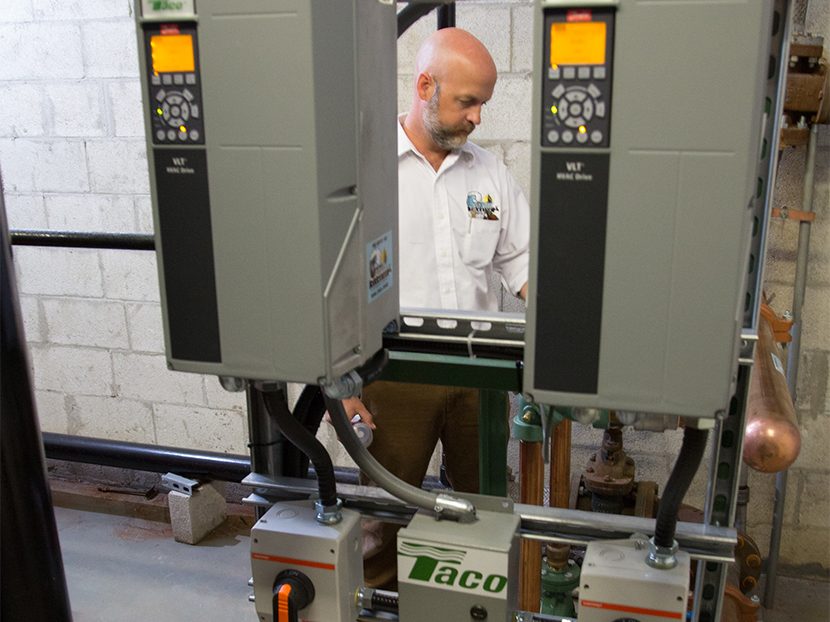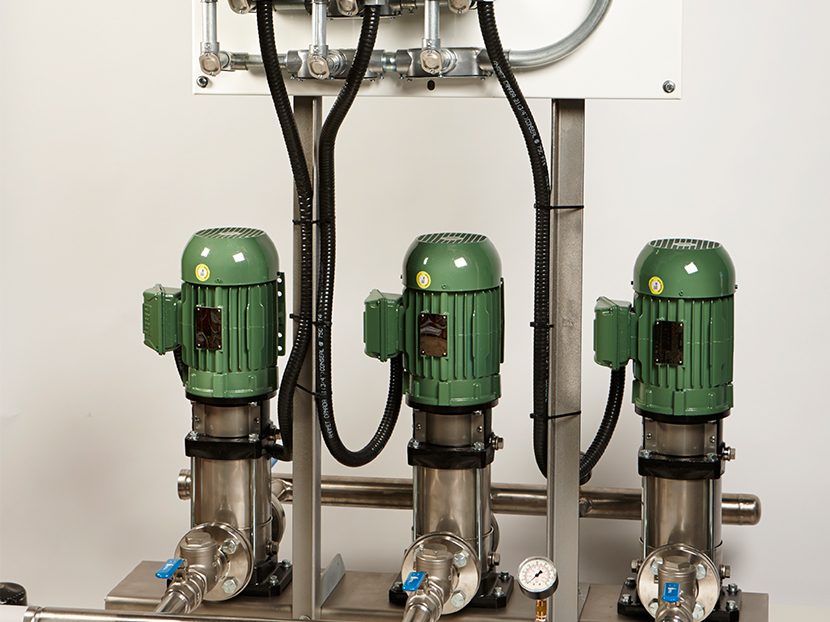Under Pressure?
Give a boost to bigger buildings.












Pity the life of commercial booster pumps, among the least understood, least appreciated and yet hardest working members of the mechanical team on any building site.
Here in America, the demand for comfort and instant gratification rule. This burden is no more apparent, or demanding, than the universal expectation that – at any height within a building, or any distance from the source of water entry – sufficient water pressure be available for any need.
The advantage with new buildings is that, with the involvement of a professional design team, a building owner can assume that a smartly designed, fully functional structure will meet or exceed the expectations of its occupants.
But what of a remodeled or expanded facility? An older structure in need of renovation? Or a building plagued with inconsistent pressure from the water supply?
Will the domestic water system get the attention it’s due? And will sufficient pressure be available on the top floor for the luxury suite’s multi-jet shower?
Welcome to the questions, the life, intricacies and joys of the modern, pumped world. Supplying large buildings with ample domestic water pressure can be a challenge, though some basic considerations and tenets apply.
It’s generally understood that, in tall buildings, the pressure provided by a municipal water system isn’t capable of meeting adequate domestic water system needs beyond a certain height. As an example, municipal water systems typically provide maximum pressures in the range of 100 to 150 psi. This may be sufficient for buildings of 20 to 30 stories. Above this height, a building will require a domestic water pressure booster system.
Out with the old . . .
Given today’s market conditions, with reduced new construction, we’ll begin with a look at building renovation and some of the variables that may play into providing adequate pressure for a large domestic water system.
Consider this: At what point in the life of a building do facility managers decide to replace a domestic water system or at least the pumps that maintain pressure within it? The answer to that question depends on many factors, including the age and condition of system components, operational performance and efficiency, and the cost and long-term advantages of system replacement.
One answer may be to conduct a rigorous energy audit of the property. It’s likely that not one, but several issues, may play into answering the question of whether or not it’s a good time to get serious about maintaining or replacing key components.
I’ve visited many buildings where high maintenance and energy costs, deteriorating domestic water pressure, mechanically fatigued pumps and the limitations of older, proprietary controls leave owners with no easy options. In instances like these, it’s not uncommon for a new pump system to be specified.
Of course, one of the key challenges to such “major surgery” – especially when the building is occupied – is maintaining service to the building’s tenants, even when replacement or retrofit work is being done.
If it’s been determined that a booster system should be installed, the next issue to address may be how to supply a substantially varying flow rate with relatively constant flow rate pumps.
To accomplish this, manufacturers avail several types of pressure booster systems. They can be loosely categorized in this fashion:
- Open tank storage systems
- Closed tank hydropneumatic systems
- Tankless systems – constant volume pumps
- Tankless systems – variable volume pumps
Open tank storage systems use an open, atmospheric tank located at the top of the building. These systems are the easiest solution in terms of pump control. Pump operation is controlled by a simple level control in the tank. The tank volume and pump flow rate are typically sized to prevent short cycling of the pump.
Since the tank is open to atmosphere, it’s subject to corrosion. In addition, the tank requires additional floor space. As a result, these systems have gradually lost popularity.
Closed tank hydropneumatic systems include a closed, pressurized storage tank. The advantage to a “captive air” pressurized storage tank, when compared to open, atmospheric storage tank, is in the size of the tank. The captive air tank is much smaller than the open tank.
Pump control – typically with a pressure switch to activate and stop the pump – is relatively simple. Pressure differences between pump on and off is generally in the range of 20 to 30 psi. Here too, tank volume and pump flow rate are typically sized to prevent short cycling of the pump.
During periods of low demand, the pump may be off for long periods of time. For this reason, the system is better suited for applications where demand reaches design flow for a relatively short time and is low for a high percentage of time.
Even with a captive air tank, corrosion can be an issue.
Tankless systems are better suited for larger buildings where the size of a storage tank is prohibitive, and the long-term maintenance of a storage tank is a consideration. Also, closer control of water pressure is possible with tankless systems employing staged or variable volume pumps.
The design objective of a booster system is to provide a stable pressure to the fixtures at the very top of the building and avoid short cycling of the pumps and shortened life.
Calculating the pressure requirement for tall buildings is a function of several variables.
The booster system pressure is the sum of the height of the building, the residual pressure at the top of the system for operation of plumbing fixtures, and the friction losses in the piping. From this total one can subtract the available municipal water pressure.
As an example, using a 40-story building with a 12-foot floor-to-floor profile, the static height of the building is 480 feet or 205 psi. For flush valve fixtures, a residual pressure of 20 psi is acceptable. Friction losses could be anywhere from 10 to 25 psi considering backflow preventers and piping. Using the higher figure gives a required pressure of the booster system of 250 psi. If the municipal water system has an available pressure of 100 psi at maximum demand, the booster system would be sized for 150 psi.
I’ll add that the pressure rating of piping and fixtures must be taken into account. As a result, tall buildings can be divided into pressure zones to limit the maximum pressure in any one area of the piping system.
In order to size the pumps, we also have to size the flow rate through the booster system. This is generally done using fixture counts or fixture units and converting this to flow rate or gpm with formulas that are available in plumbing codes or the ASHRAE Guide.
The conversion of fixture units to flow rates is accomplished by use of the Hunter Curves. Hunter Curves are formulas that convert fixture units directly to gpm. The curves are based on use patterns observed in actual buildings and take into account the demand factor for domestic water systems, since not all the fixtures will be calling for water at the same time.
What we want to avoid, of course, is oversizing the pumps because that leads to unnecessary expense. Oversizing pumps could also shorten equipment lifespan if the pumps short cycle frequently.
Constant, or variable?
Now that we’ve calculated the maximum needed pressure and flow rate, we can make an intelligent decision about the pumps required and how best to control them.
There are several ways to take a constant flow rate and convert it to variable demand. This could be accomplished with equal sized pumps in a duplex or triplex configuration. However, if the pumps were of equal size and there was a wide variation in flow (as in an apartment building), it would be difficult to keep the pumps from short cycling.
Systems using on-off control typically use a smaller (jockey) pump in combination with a larger pump(s). The jockey pump is controlled to maintain the pressure at low flows. The larger pumps (in combination with the jockey pumps) are controlled to maintain pressure at high flow.
Widely regarded as the best solution – now, especially considering the much more competitive price of variable frequency drives (VFDs) for pumps – is to operate pumps in combination with VFDs. With variable speed/variable frequency drives, duplex and triplex systems can use pumps of equal size and best efficiencies. In essence, the pumps are sized for maximum efficiency rather than maximum flow.
Municipal water systems are also converting from open atmospheric water towers to variable speed systems for the same reasons, abandoning water towers for new uses.
Other considerations
The other key element to contemporary pressure booster system is the control function. The control system consists of a remote-mounted pressure sensor or transducer, a controller and a controlled device or pump.
The pressure transducer takes a mechanical signal and converts it to an analog signal. The signal is sent back to the digital pump controller. The controller takes this input and compares it to the system pressure setpoint. This differential is converted to a control signal and sent to the pump’s variable speed drive to alter pump speed.
Digital controllers can now use a time function in the control algorithm to prevent hunting of the variable speed drive. Hunting is a condition where the drive ramps up and down trying to reach the control pressure setpoint. This is generally a result of using just a P or proportional control algorithm. With digital controllers this can take the form of an integral function in a PI (proportional plus integral) controller or an additional derivative function in a PID (proportional plus integral plus derivative) controller for more stable operation.
Another benefit of variable speed control is energy consumption. Pumps can now be selected based on their best efficiencies. This is a big improvement when compared with pump selection based on maximum system flow rates.
Next time you face a need for domestic water booster pumping, consider a variable speed booster pump system to efficiently deliver water to the top story of a building. Affordable, advanced technology now provides optimal control and energy efficiency.




